Is the NZ Infrastructure Pipeline on track?
Thoughts on the draft Infrastructure Commission - Te Waihanga Infrastructure Plan
POLICYRESILIENCECLIMATE CHANGEFINANCEPLANNINGFREIGHTINFRASTRUCTUREINVESTMENT
Mark Gasson
8/12/20259 min read
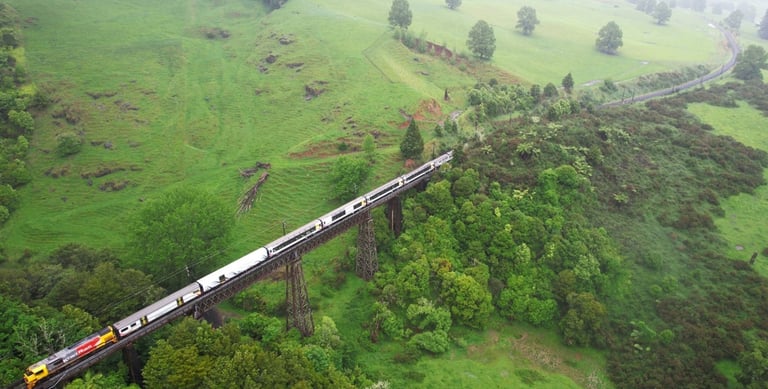

Northern Explorer crossing the Waiteti Viaduct near Te Kuiti, image by Geoff Mackley.
The Future is Rail recently submitted our response to the draft Infrastructure Commission - Te Waihanga Infrastructure Plan. We reviewed specific aspects, within the context of our areas of expertise and advocacy for sustainable rail. The Infrastructure Commission - Te Waihanga, has a remit ‘to transform infrastructure for all New Zealanders’, in a way that will ‘lift the economic performance of Aotearoa and improve the wellbeing of all New Zealanders.’
The view of the members and supporters of The Future is Rail is that the assessment criteria for appropriate infrastructure to enable the sustainable development of Aotearoa New Zealand, must consider the following four principles -
· Reducing emissions
· Shifting transport to low energy use modes to maximize use of renewables
· Maximising mobility options to support socially well-connected communities
· Ensuring our roads are safe, appropriately funded, and sustainably maintained
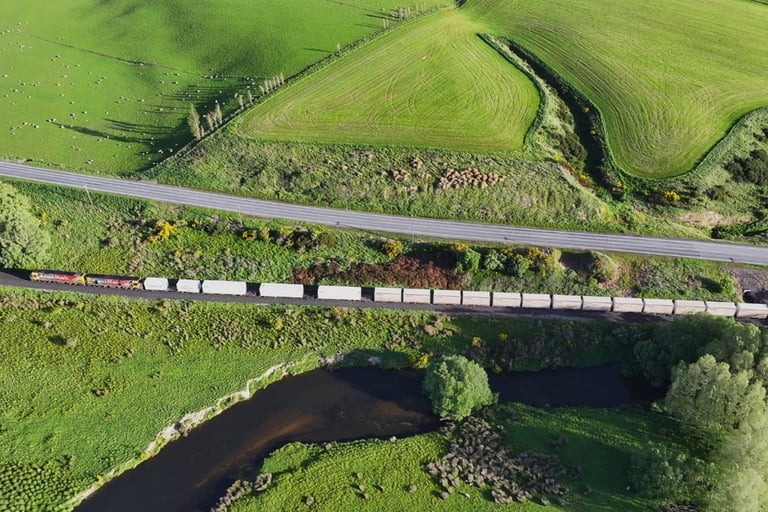

KiwiRail train and quiet highway in rural Southland, image by Geoff Mackley.
These principles complement the "four well-beings" referring to the social, economic, environmental, and cultural well-being of communities, which local governments were until recently legally required to consider in their decision-making. They also support Kaitiakitanga, the Māori concept of guardianship and stewardship, emphasizing the responsibility to care for and protect the natural environment, including land, water, and resources, for the benefit of present and future generations.
It is interesting to observe that the Infrastructure Commission - Te Waihanga, has set out their own four key principles -
Establishing affordable and sustainable funding. We spend a lot on infrastructure, but it's challenging to keep up with rising costs and to balance with other demands for taxpayers’ money. This means we need smarter ways to fund what we build and look after.
Clearing the way for infrastructure. Complex rules, changing policies and poor coordination make it slow and expensive to get things built. It also makes it hard build up the workforce required to build and maintain what we need over the long-term.
Starting with maintenance. Too often we prioritise new projects while the infrastructure we already have runs down. In the long run, this leads to higher costs and can make services unreliable.
Right-size new investment. We often launch major infrastructure projects before they’re ready, without proper planning or being clear on how we’ll pay for them. This can lead to delays, projects costing more than expected, and communities not getting all of the services they need.
The Future is Rail doesn’t necessarily disagree with the four areas highlighted by the Infrastructure Commission - Te Waihanga. However, it does seem clear that the priorities are different.
With the notable exception of support for Greater Christchurch Mass Transit, there has been no indication that the Commission has any great interest in low emissions, environmentally sustainable mobility options, that support socially well-connected communities.
The other two shortlisted transport projects are a Manawatū Regional Freight Ring Road, and the Waikato based Ruakura Eastern Transport Corridor. These two regional roading projects focus on connections for freight movement, employment trips and residential movements. They have promise, given the considerable work being done on multi-modal logistics hubs, in both these two regions. However, The Future is Rail is concerned about some of the other roading projects that have made their way onto the ‘The National Infrastructure Pipeline’. In particular, we have observed the silence from the Commission, on the latest round of RoNS Projects (Roads of National Significance) that appear in the pipeline.
Our own work used the data provided by NZTA, MoT and other official sources, to identify the poor economic return on many of the first tranche of RoNS projects, and subsidies enjoyed by heavy vehicles such the trucks (HPMVs), that have impacted on regional community roading budgets.
Recent cost overruns on the Ōtaki to north of Levin (O2NL) highway, bring further urgency for the Commission to take a clear policy position on the economic efficacy of these large mega roading projects.
The Future is Rail acknowledges the analysis that the Commission has undertaken on roading and rail across a number of comparator countries. This includes the diagram below:


This snipped image is part of Table 2 on page 36 of the draft Infrastructure Commission - Te Waihanga Infrastructure Plan. The statistics regarding investment, quantity and quality of the rail network stand out starkly, relative to comparator countries. The caption is titled; ‘Comparing New Zealand’s infrastructure networks against our peer countries’. An accompanying heading notes that ‘Some of our infrastructure networks compare better than others.’
The Commission noted the following:
• Our rail networks are characterised by very low levels of investment and low usage, for both passenger and freight rail. The length of our network is comparable to our peers, although our network electrification is low. New Zealand’s rail services also score comparatively poorly on measures of rail quality.”
The Future is Rail considers the statement; New Zealand rail networks are characterised by ‘low usage’, as needing to be a little more nuanced. Usage of rail, relative to comparator countries, could be argued to be relatively well performing, given appalling quality and investment levels compared to comparator countries. How much better could rail in New Zealand do, with smart investment to improve quality?
The Commission made the following comment that perhaps indicates a level of institutional bias:
“Rail networks are, or should be, primarily funded by users in the form of track user charges. This includes contributions from urban public transport users and local governments, for access to urban passenger rail networks.”
Reflecting a little balance perhaps, the Commission also provides the following comment and graphic about predicted cost recovery for new Toll-roads:
‘Projects that provide high benefits to many users, at an affordable and certain cost, are more likely to be able to generate new revenues to help pay for investment. For example, new toll roads can pay for themselves in some situations but not others
The bar is high for projects to be fully self-funding.’
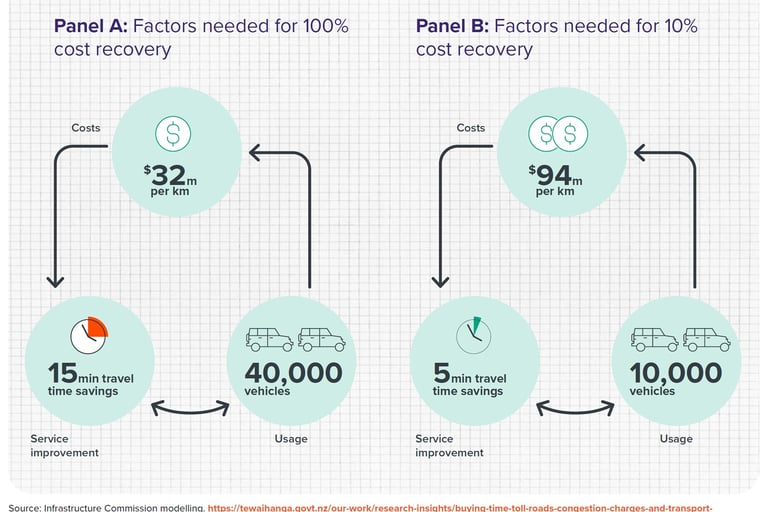

Figure 37 on page 122 of the draft Infrastructure Commission - Te Waihanga Infrastructure Plan. The caption is titled; ‘Predicted cost recovery for new toll roads’. An accompanying heading notes that ‘Revenue tools are more effective when project quality is high.’
When considering the economics of the proposed ~100km RoNS Northern Motorway, it is noted that both the NZIER Report and Motu Research’s critique, quote between $5.6 and $11 billion to build the Southern (Warkworth to Whangārei) and Northern (Whangārei to Kaikohe) sections. This equates to a cost of $56 to $110 million per km to build a road. Blogsite Greater Auckland , noted that main highways into Northland currently carry ‘only around 10,000 vehicles per day crossing the Brynderwyns’. The RoNS Northern Motorway carries especially high construction risk, due to ongoing stability issues with the geology of the Northland region, and vulnerability the region to weather events.
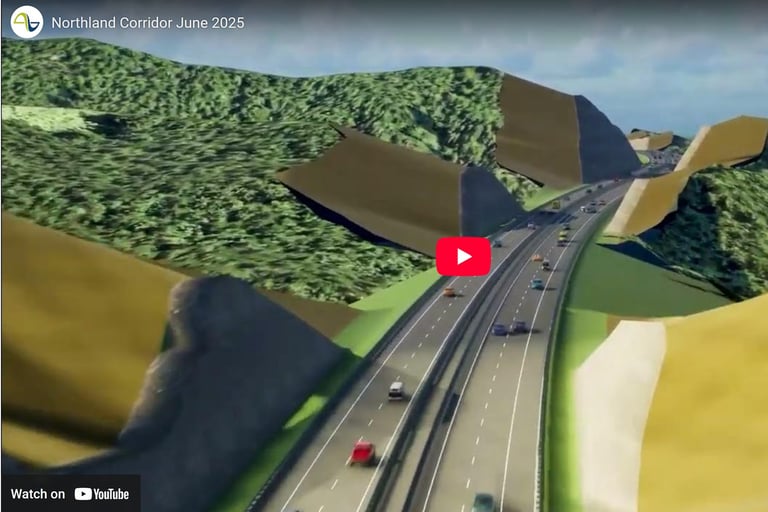

YouTube image of the proposed new RoNS Northland Motorway, image from Greater Auckland blogsite
The Infrastructure Commission - Te Waihanga, has a worthy ambition to take on the role, as a solid and independent source of advice, enjoying cross-party political support. For this to happen, the project assessment process, for inclusion in the ‘The National Infrastructure Pipeline’, needs cross-party consensus. It is likely that any lasting consensus, will also need to consider coalition partners, in any current and future government.
The Future is Rail, initially made an application to the Commission, for consideration of augmented funding for the Rail Network Investment Plan (RNIP) in the infrastructure pipeline. At that stage, the 2024-2034 Government Policy on Land Transport (GPS), had funding available for Rail Network activity class dropping to the just $20 million per year, under a ‘lower scenario’, from 2026-2027. This would have seen the end of the national rail network outside of Auckland to Tauranga, and Auckland and Wellington metro passenger operations. The RNIP is the key investment input that sustains the national rail freight and tourism rail network.
The Future is Rail submission for boosted RNIP, was going to include funding for continuing weather resilience enhancement for the national rail network, and targeted funds towards Capex support; for example: specialised fertilizer wagons, industrial sidings, and container and log transfer sites.
Our RNIP focus was going to be on bringing rail freight rates down, so rail could help regional industry, was more competitive with truck trips on regional roads, and could enable regions to reduce their road maintenance costs. The Future is Rail, was concerned that KiwiRail, as directed by their shareholder, would only submit projects to the infrastructure pipeline, that concerned core metro regions. We are keen to bring a wider national focus to the Infrastructure pipeline.
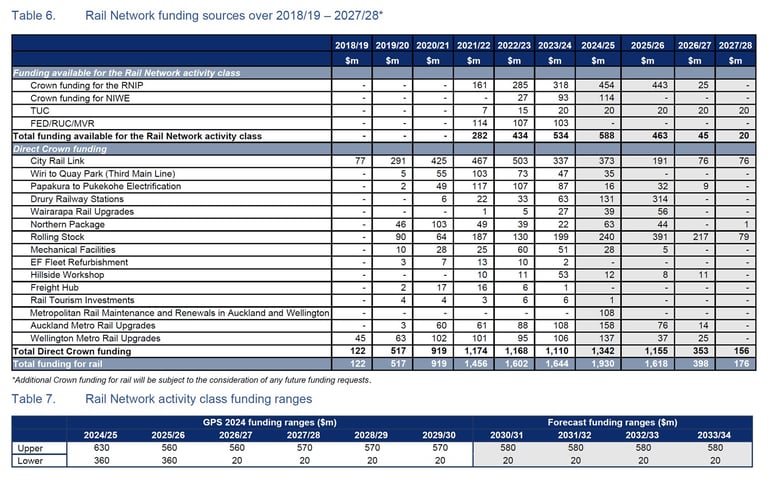

These two tables are on page 36 of the Government Policy Statement on land transport 2024/25–2033/34. Accompanying text noted that; ‘The GPS expects that the RNIP will be equal to or less than the available funding outlined in Table 6 and within the funding ranges set out in Table 7’.
In good news for supporters of rail; an updated RNIP Plan was subsequently released with funding revised upwards. There is funding certainty between 2024 and 2027, at levels similar to previous years. It should be noted however, that there has been a change in emphasis towards ‘priority routes’ in the current RNIP.


This table is on page 57 of the Rail Network Investment Programme 2021-2024. The caption is titled; ‘Schedule One, National Freight and Tourism Network – Rail Network Activity Class. Accompanying test - ‘As noted throughout the RNIP, the primary focus for the Rail Network activity class is to fund the continuous programme of investment in a resilient and reliable national freight and tourism rail network.’


This table is on page 65 of the Rail Network Investment Programme 2024-2027. The caption is titled; ‘Schedule One, National Freight and Tourism Network – Rail Network Activity Class. Accompanying test - ‘As noted throughout the RNIP, the primary focus for the Rail Network activity class is to fund the continuous programme of investment needed to improve level of service in priority routes and maintain safety and compliance in secondary routes.’
It remains clear, as outlined within the draft Infrastructure Commission - Te Waihanga Infrastructure Plan, and within our own response, that rail investment in New Zealand remains substantially lower, than Australia, and ‘comparator’ OECD countries.
Although The Future is Rail provided a detailed evidence-based submission, the application unfortunately was declined by the Commission. Difficult and demanding decision-making processes, faced by the Commission, are acknowledged, given the multiple current and future infrastructure demands, within an uncertain landscape. The Future is Rail looks forward to future conversations with the Infrastructure Commission - Te Waihanga, given our concerns over process and criteria.
In closing, it should be noted that Road User Charges (RUCs), have received considerable media coverage over the past week, on the back of the government announcement to phase out petrol tax, and replace the tax with a universal RUC, most likely managed by a third-party privately-owned entity. The Future is Rail considers this blog by Greater Auckland to cover the issues well. We will support the Infrastructure Commission - Te Waihanga, in providing assurance that the RUC fees will fall upon the users who do the most damage to the roads, who drive the engineering requirements for such things as roading surface construction and maintenance, and high-cost infrastructure such as bridges.
One of the more succinct comments we have read is from Environmental Engineer Stephan Heubeck:
“The link between excise tax, RUC and road infrastructure funding / roading CAPEX and OPEX simply doesn't exist anyway. We've been through the disproportionate effects of heavy vehicles on road wear and tear, but on top of all this, half the roading infrastructure we have in NZ, aka the council roads, are funded by rates - which have nothing to do with neither excise tax nor user pay charging anyway. So why is everyone so hell-bent on constructing a link between "cost reflective road use charging" that doesn't exist in the real world, and has never existed - only to justify a new convoluted and unjust new bullshit RUC system punishing energy efficiency? The only measurable outcome of all this will be a disastrous one for our environment.”
